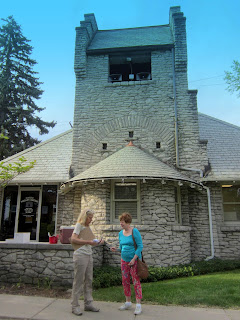 |
| Grounds and sample mausoleum; a Harroun family in-ground plaque; pink-flowered horse chestnut; the Ottawa river; a home for ducklings. |
My friend Teddy and I had a lovely stroll through the park-like setting this morning, up with the birds, lots of them. We needed a "birder" to identify them, and in fact the Cemetery does offer "birder tours," among many others. These programs keep hope alive.
To this day, Woodlawn embodies and reflects the vision of its founders and its first superintendent, horticulturalist Frank Eurich.
 |
| Teddy with assistant director Patty Toneff in front of unique Gothic administration building with famed bell tower, which still tolls the arrival of funeral processions. |
Graceful monuments, in-ground plaques, elegant statuary and loving memorials rest peacefully along flowering paths, gently rolling hills, on lakes
and along an Ottawa river tributary .
There are 42 mausoleums of many designs, many classical with Greek and Roman columns and flourishes, many with original Tiffany windows (which theToledo Art Museum
There are 42 mausoleums of many designs, many classical with Greek and Roman columns and flourishes, many with original Tiffany windows (which the
Woodlawn abounds in wonderful funereal art and architecture. Some memorials are unique, like the cement tree stumps popular in their day (Teddy is viewing one at left), or the large pyramid of stones from around the world built to honor John Gunckle, founder of the Toledo Newsboys Association.
The cemetery was run down and neglected for a while, threatened with ruin, until a group of dedicated citizens organized to fight for its life. It was a fitting effort, and the cemetery is now a National Historic site run by a
private nonprofit dedicated to its maintenance, restoration and
preservation. Its trustees are doing a conscientious job of
preserving the beauty and historic significance of this special place. They offer many programs, tours, and of course funeral services. They are considering a green burial area. We the citizens of the Toledo area, and wherever in the US the rural cemetery movement came to life, are grateful beneficiaries. History, art and nature: the beauty of our lives here and beyond.






No comments:
Post a Comment